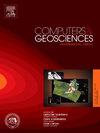瞬变电磁法测量数据的物理嵌入深度学习反演
IF 4.4
2区 地球科学
Q1 COMPUTER SCIENCE, INTERDISCIPLINARY APPLICATIONS
引用次数: 0
摘要
瞬变电磁法(TEM)是一种广泛应用于复杂地质条件调查的地球物理技术。深度学习(DL)为解决复杂的非线性瞬变电磁法反演问题提供了一种新的方法。然而,目前大多数深波反演方法严重依赖于标记数据(真实电阻率模型),难以从现场调查中获得。在这项研究中,我们提出了一种基于控制电场传播的物理定律的TEM测量数据的无监督深度反演方法。首先,我们将正演建模集成到训练过程中,允许将预测电阻率模型转换为模拟数据。然后将模拟数据与观测数据进行比较,以计算数据不匹配。然后,利用数据失拟作为损失函数实现无监督训练(标签无关),并采用动态平滑约束来缓解不适定反演问题。此外,DL网络结合了注意机制来提取TEM反演的关键特征信息。最后,采用鲸鱼优化算法(WOA)优化的多元变分模态分解(MVMD)技术,降低调查数据中的噪声,提高瞬变电磁法反演精度。综合算例和现场实测表明,我们的方法能够准确地描绘出地下模型结构,为瞬变电磁法反演提供了一种创新的解决方案。本文章由计算机程序翻译,如有差异,请以英文原文为准。
Physics-embedded deep learning inversion for transient electromagnetic method survey data
The transient electromagnetic method (TEM) is a widely used geophysical technique for investigating complex geological conditions. Deep learning (DL) provides a novel approach for solving the complex, nonlinear TEM inversion problem. However, most current DL inversion methods for TEM survey data depend heavily on labeled data (real resistivity models), which are difficult to acquire from field surveys. In this study, we propose an unsupervised DL inversion method for TEM survey data based on the physical laws that govern electric field propagation. First, we integrate forward modeling into the training process, allowing the predicted resistivity model to be converted into simulated data. This simulated data is then compared with observed data to calculate a data misfit. Then, unsupervised training (label-independent) is achieved using the data misfit as the loss function, with dynamic smoothing constraints employed to alleviate the ill-posed inversion problem. Furthermore, the DL network incorporates an Attention mechanism to extract crucial feature information for TEM inversion. Finally, the multivariate variational mode decomposition (MVMD) technique optimized by the whale optimization algorithm (WOA) is adopted to reduce noise in the survey data and enhance TEM inversion precision. Both synthetic examples and field surveys show that our proposed approach accurately delineates subsurface model structures, offering an innovative solution for TEM inversion.
求助全文
通过发布文献求助,成功后即可免费获取论文全文。
去求助
来源期刊

Computers & Geosciences
地学-地球科学综合
CiteScore
9.30
自引率
6.80%
发文量
164
审稿时长
3.4 months
期刊介绍:
Computers & Geosciences publishes high impact, original research at the interface between Computer Sciences and Geosciences. Publications should apply modern computer science paradigms, whether computational or informatics-based, to address problems in the geosciences.
 求助内容:
求助内容: 应助结果提醒方式:
应助结果提醒方式:


